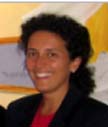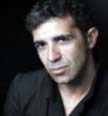The Use of Drama-Therapy in the Rehabilitation of Stuttering Patients
About the presenters:
 |
Dr. Donatella Tomaiuoli Psychopedagogist, expert in treatment and rehabilitation of language disorders, and CRC Director. Specialized in stuttering treatment, she developed a specific therapeutic program which achieved excellent results and is an object of international interest. Adjunct Professor of "Integrated Course in Glottology and Linguistics I" at the University of Rome "La Sapienza", where she is also tutor for stuttering. She has presented at several meetings in Italy and abroad. |
 |
Francesca Del Gado CRC logopedist. Specialized in rehabilitation treatment of adults who stutter, she also deals with voice disorders, velopharyngeal insufficiencies, rehabilitation treatment of tubal stenosis. She is Internship coordinator for students in Logopedics of the University of Rome "La Sapienza". She is also involved in training and meeting activities. |
| Paola Falcone Researcher, trainer and consultant, she is responsible for the research and training programs at the CRC. | |
 |
Calogero Marchese started his professional career as a portraitist photographer; this experience made him discover the importance of the body in order to convey feelings, so he attended and graduated from the "Ecole Internationale de Theatre Jacques Lecoq - Paris". Through the years, he blended his background with other styles, from the Russian Petru Vutcarau's, to New Yorker Gaby Ford's, to Tom McLane's, of the English Royal S. Company. He conducts the theatre laboratory at CRC. |
 |
Eleonora Pasqua CRC logopedist. Specializes in the rehabilitation treatment of teens who stutter, she is also responsible for the evaluation and treatment of learning, specific language and communication disorders in evolutive age. She is a University tutor in the Language Disorders course in Logopedics, and senior year student in Education Sciences at the University of Rome "La Sapienza". She is also involved in training and meeting activities. |
 |
Maria Grazia Spinetti CRC logopedist. Specializes in rehabilitation of preschoolers and school-aged children who stutter and in phoniatric pathologies. Thanks to her attested experience she is now responsible for the enrollment of patients in the therapeutic program. She is also involved in training and meeting activities. |
The use of drama-therapy in the rehabilitation of stuttering patients
by Donatella Tomaiuoli, Francesca Del Gado, Paola Falcone, Calogero Marchese, Eleonora Pasqua, and Maria Grazia Spinetti
from Rome, Italy
Introduction
The therapeutic intervention of people who stutter has been traditionally centered exclusively on individual logopedic (speech) therapy, mainly focused on the stuttering speech symptoms. Logopedic therapy often has positive results in terms of fluency improvement and still represents the core of rehabilitation; however, it can be enriched by integrative therapeutic tools able to intervene on the variables associated with the disorder. Our team has been carrying out for fifteen years rehabilitation practice through an integrated approach which includes traditional therapy, group activities and drama-therapy, with particularly encouraging outcomes.
Reasons why theatre has been inserted in the rehabilitation program
The design of a rehabilitation intervention integrates both traditional and drama-therapy, stimulating the person who stutters to go beyond the static boundaries of the traditional logopedic therapy. Patients' needs, in fact, often require a rehabilitation program not limited to the sole treatment of the symptom, but involving the whole person. The need for a global approach to the person, aimed at a stimulating and validating of all the personal dynamics, has been obvious to us from the beginning of our therapeutic experience. It was necessary to suggest to patients many different activities, aimed at testing both their verbal and non-verbal skills and allowing them to challenge themselves in different contexts from their usual ones, thus improving their own self-esteem, which may be particularly compromised in patients who stutter. In fact, durable outcomes can be obtained only by dealing with their spontaneous individual defences. Obviously, in order to motivate patients to practice for several hours-per-week, the activities had to be captivating and creative, not stressful.
Furthermore, group activities are desirable, since they have a two-fold advantage: they lighten the therapy burden and they allow patients to emerge in their own identity. On one hand, in fact, they require group members to accept pre-existent rules and on the other hand to contribute to create new ones. Group activities also require the ability to evaluate when to take leadership and when to wait and follow others, according to different situations and dynamics. The ideal solution, for its therapeutic worthiness, could be nothing but theatre.
According to the definition given by the National Association for Drama Therapy (NADT ), drama-therapy is "the systematic and intentional use of drama/theatre processes, products, and associations to achieve the therapeutic goals of symptom relief, emotional and physical integration and personal growth". Its earliest applications date back to 19th century and concerned treatment of patients affected by mental illness. Through the years, the healing power of theatre has had many different applications: the use of an artistic medium makes drama an active and creative kind of therapy allowing an integrated action on diverse variables, such as emotion, voice, individual characterization and expression, gestures and movement. In fact, theatre allows work simutaneously on:
- verbal communication, through the generalization of learned verbal facilitation techniques;
- non-verbal communication, through improvement in the efficacy of body language, the use of voice and the ability to express emotions.
Thanks to our work, patients gain more knowledge and awareness of their body and of themselves, learning to accept their own limitations and validating their strengths. Theatre stimulates individual creativity, by allowing those who practice it to put themselves in someone else's shoes, playing different roles and facing often demanding situations different from the everyday. This activity allows patients to experience and acquire more flexibility and ability to face changes, allowing them grow in self-esteem, making them stronger and, at the same time, reducing their fears (not just those connected with speaking) and promoting their personal growth. Last but not least, the benefits also positively affect patients' relationships, since they become more spontaneous, thus reducing their rigidity which is often typical in their social behaviour.
Some data about the experimentation
Through the fifteen years of experimentation, 510 patients have been treated according to the integrated protocol, benefiting from drama-therapy. 360 of them were males and 150 females - in a proportion male-female of 4:1, as a consequence of the gender difference in the incidence of stuttering. The treated patients were from all the age groups: children (40%), adolescent (30%), adults (30%).
The rehabilitation program
The rehabilitation treatment lasts one year. At the beginning, after the therapeutic alliance is established, the logopedist begins individual work on patient's verbal communication, mainly aimed at an improvement in the pneumo-and phono-articulatory coordination and the acquisition of verbal facilitation techniques. As the patient carries out individual logopedic therapy, he/she also begins, with other people of his age group, some group activities promoting verbal expression in different contexts, by drawing on everyday situations (phone-therapy and so on). At the end of this first step, lasting four months, the patient add theatre training to logopedic therapy. At this stage, logopedic therapy focuses on group activities aimed at solidifying what patients have learned in the first stage, through therapeutic settings with different subjects and activities. At the same time, theatre laboratory begins. Patients are not always happy to begin this new kind of therapy. The fear of facing a new situation produces a typical avoidance reaction, accompanied by many doubts about on their participation.
The theatre laboratory is conducted by a professional actor and director with the collaboration of a logopedist and lasts 7 months, with a schedule of 2-4 hours a week. During this time, participants work on the development of their non-verbal language, articulation, breath improvement and vocal strengthening. The exercises are taken from the best international repertory, from the French School of the "Com�die de l'Art", to Jacques Lecoq's contemporary school, to the Royal Shakespeare Company English School, and the Russian National School. All this makes the work style very specific and allows patients to have an experience which is methodologically sound and stimulating at the same time.
After the first stage of learning the basic techniques, patients practice using pantomimes, interpretation and improvisation. At this stage it is possible to work in a structured way on modelling, adapting the acquired techniques and tools addressing the patients' individual needs. Training, aimed at therapeutic purposes, has a motivating goal in preparing and putting on a play in a real theatre.
Usually the chosen play is a comedy, since it allows patients to test factors useful in therapy, such as irony. In recent years our team has successfully chosen to use a script open to possible adaptations made by the patients-players, together with the director, during the rehearsals. In this way, new cues can be added, as well as performances in line with personal features and talents (i.e. singing, dancing). The experience is more enriching, since participants can better express themselves and realize they can customise the script, as they can adjust other scripts connected with the roles they can choose, or be called upon, to play in their real lives. The performance experience remains an unforgettable memory in patients' minds.
The time immediately preceeding the performance is very delicate to manage, since in many cases it triggers all the typical fears of the people who stutter: feeling unable to completely rely on themselves, and now are going to be on a stage and perform before an audience, surrounded by silence and dark. Once again the reaction of avoidance is a concrete temptation. Psychological support is necessary, especially for some.
On the day of the play, tension rises -- everything is ready: stage, scenery, customes, make-up. Participants have their final rehearsal and then start the play. It's always a great test for them and they always overcome it. Even when they feel they are about to block, they succeed in managing. Improvisation frequently supports them, by making them replace the word which could cause a block with another one, or by inducing them to ask and receive support from other players on the stage.
While patients act, therapists evaluate their ability to manage time pressure and the difficulties connected with a speech block, looking for alternative solutions to suggest. In fact, since the play represents both ordinary verbalization experiences and the purpose of the therapeutic program, it is always interesting for therapists to observe patients at work and study their behaviour.
Once the play is over, an intense adrenaline remains; actors go and celebrate, because they know they have achieved an important goal for themselves: the experience they went through becomes a positive reference point in their memory and each time they face other trials, they remember their success. The play will be debriefed, through a collective session analyzing everything that occurred. The therapeutic program is coming to an end. During the last two months, patients work on generalization of acquired techniques and continue logopedic therapy, integrated with outdoor verbalization experiences personalized according to individual difficulties.
What patients think of their theatre experience: the findings of a survey
In May '07, our research team made a qualitative survey of the patients who had taken part in the current year's play. The most interesting findings are shown below.
Before approaching the theatre laboratory, not all of the participants were for it: 58% of them had a negative attitude, considering it too difficult for them. The remaining 42% had a positive attitude, considering it a challenge and pleasant experience. After the initial theatre sessions, those who had a positive attitude had their expectations confirmed, while the others changed their minds, as they realized that the laboratory was an exciting experience. All participants in the theatre laboratory affirmed they felt at their ease in the group. Not all the activities during the theatre laboratory were considered easy to perform by patients. Interestingly, not all the participants found the activities related to the use of the voice more difficult to perform than those related to the use body movements: 40% of patients interviewed considered the latter more demanding than the former.
It is worth noting that those who feared the theatre experience found the activities related to the use of the voice more difficult than those related to the body. Final evaluations about the laboratory were positive for all the patients: training improved awareness and the use of non-verbal communication for all participants allowed them to feel more at ease than before in their everyday verbalization experiences. In terms of generalization, it was observed that avoidance of speaking decreased, the use of verbal facilitation techniques improved, as well as the ability to communicate in everyday situations, with improvement in interpersonal relationships. It is also worth noting that one patient out of three stated after the theatre laboratory felt he stuttered less than before.
Conclusions
Through these years of experimentation, the integrated protocol which blends traditional therapy, group activities and theatre laboratory showed to be a particularly effective therapeutic tool, producing remarkable results in patients. Work aimed at acquisition of verbal facilitation techniques, through both individual therapy and group activities, is the first essential step to train patients in facing the theatre laboratory experience and its difficulties with more self-confidence. The most relevant outcomes pertain to a general improvement in both verbal and non-verbal communication, the ability to manage anxiety in stressing contexts and a greater confidence in one's own communicative and relational abilities. The attested generalization of the learned techniques into different everyday situations is the most encouraging outcome in terms of enduring results, after therapy is completed.
August 12, 2007

